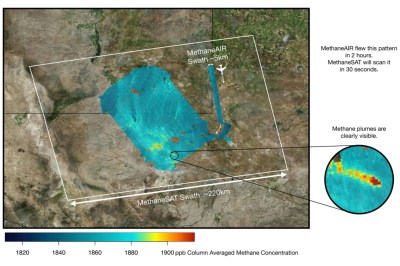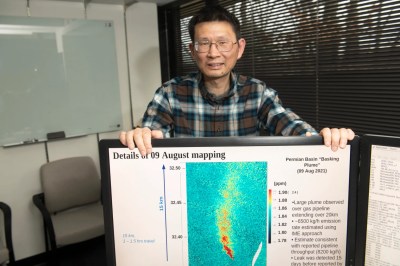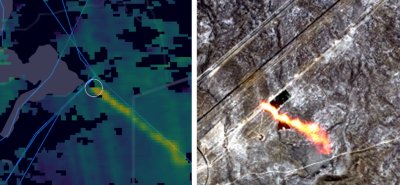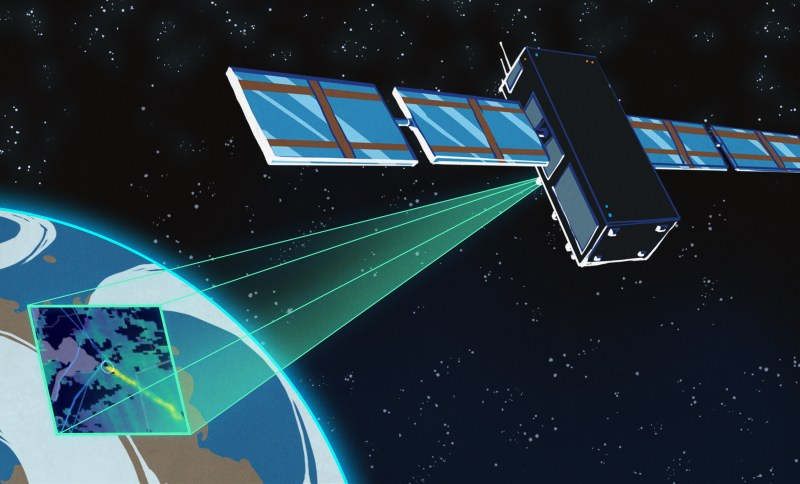Much of the reporting around climate change focuses on carbon dioxide. It’s public enemy number one when it comes to gases that warm the atmosphere, as a primary byproduct of fossil fuel combustion.
It’s not the only greenhouse gas out there, though. Methane itself is a particularly potent pollutant, and one that is being emitted in altogether excessive amounts. Satellites are now on the hunt for methane emissions in an attempt to save the world from this odorless, colorless gas.
Bad Gas
Methane stands out as an extraordinarily effective greenhouse gas, carrying a warming impact 28 times greater than that of CO2 on a weight-for-weight basis over 100 years. Prior to industrialization, it primarily originated from natural reservoirs, such as microbes breaking down organic matter in still bodies of water, or from melting permafrost.
Today, contemporary scientific consensus suggests that roughly 60% of the methane present in the atmosphere can be attributed to human actions. The agricultural sector plays a significant role, as livestock, especially ruminants, are significant producers of methane. As the global appetite for meat and dairy products shows no signs of decreasing, this source of emissions presents a challenging obstacle. Beyond farming, waste management facilities and sewage treatment plants release considerable amounts of methane. The substance is frequently a byproduct of both oil and gas extraction operations. Leaks from industrial facilities and municipal natural gas systems are not uncommon.
Historically, the concentration of methane in the atmosphere has been relatively small in comparison to carbon dioxide. However, recent years have seen levels rise beyond previous expectations, which could pose a challenge for the world’s efforts to stem rising global temperatures.
Hunt From The Skies
The fact of the matter is that you can’t quash what you can’t see. Without knowing where increased methane output is coming from, it’s hard for researchers and administrators to know where to start fixing the issue. Thankfully, there are tools that can help track down sources of methane emissions.

MethaneSAT is the headline project in this area. Scheduled to launch in early 2024, the satellite is the result of a collaboration between Harvard researchers, private space companies, activists, philanthropists, and the coordinating Environmental Defense Fund. Typically, full-scale satellite design and launches are the purview of multi-billion-dollar companies and governments alone, but MethaneSAT has been developed by a coalition on a mission.
Principle investigator Steven Wofsy noted the group’s hard work to make the project a reality after he costed the project at tens of millions of dollars. “We brought that back to EDF, and we assumed that that was the end of it,” Wofsy said. “But they went ahead and raised enough in private philanthropy to fund this thing.”

The goal of MethaneSAT is to allow monitoring a wide area for sources of methane emissions far more quickly and easily than existing aerial-and ground-based methods. The prime instrument on the satellite is a spectrometer.
As light reflected from the ground passes through the atmosphere, the spectrometer can capture the telltale signature of methane in the spectrum of light it receives. A plume of methane in the air from a landfill, farm, or pipeline leak will become readily apparent as the satellite passes over. When leaks and strong sources are identified, then something can be done about it.
Existing Work

MethaneSAT won’t be the only game in town when it launches in early 2024. Other researchers have already been using satellites to monitor methane emissions around the world.
Recent surveys by NASA have shown “mind-boggling” emissions of methane from fossil fuel fields in Turkmenistan. The methane releases were so great, they effectively equaled the UK’s total annual emissions in equivalent tons of CO2. Suspicions are that operators in the area may be simply venting methane to the atmosphere now that “flaring,” or burning off excess methane, is frowned upon. Due to the potency of methane as a greenhouse gas, this is actually far worse for the climate.
The European Sentinel 5P satellite has also been put to work on this task. Using the Tropomi, or Tropospheric Monitoring Instrument, on the craft, researchers identified broad areas of interest that could be a source of higher methane emissions. The data revealed gas leaks from wells in the US, as well as emissions from pipelines feeding gas from Russia to Europe. These hotspots can also be used guide investigations with more precise satellites run by Canadian operator GHGSat, researchers can identify sources of methane emissions down to a resolution of 20 meters or so.
The First Step
Satellites are a great tool to hunt for methane emissions. Sadly, though, finding leaks and heavy emitters is just the first step in solving the problem. The real hard work starts when it comes time to fix leaks and reduce excessive pollution from industrial sources. As always, knowing is half the battle.

















activated charcoal suppositories for cows?
Nah. Pilot lights on their tails. The CO2 left from burning the methane is far less a problem than the CO2.
Bonus: Cows wielding flamthrowers. “Mooooo!” “Braaaaaap!” “FOOOOOOM!”
Meanwhile, in Germany: https://nationalpost.com/news/explosion-caused-by-cow-farts-literally-blows-the-roof-off-barn-in-central-germany-one-bovine-treated-for-burns
And it´s not the only time it occurs.
There are efforts on breeding low-methan-emitting cows https://www.popsci.com/climate-cow-fart/
as well as inoculating them with GMO bacteria or bacteria from other species: https://www.sciencedaily.com/releases/2023/02/230214154008.htm
There are also studies about the different silage option vs methane emissions.
But the biggest impact would be that humans simply eat less meat.
Seaweed if memory serves.
No, the reason cows generate methane is because they are not being feed their native diet. Also, they burp most of it.
LOL! A billion more humans/decade since the early 60s. THAT’s the hottest fuel driving almost all causes of climate change. Sorry, no undo button. Stupid self-destructive humans.
That actually makes more sense than the climate change fanatics we keep hearing from :D . And what part of the planet population is causing the increase….
And which population produce the most methane waste per capita… likely not those whose population increase the most…
The gas age was started in Indiana, the first pipeline daytime streetlights etc. at the turn of the last century. It is estimated that 90% of that gas field escaped and kicked off climate change for the next century plus.
Population, repeat 10,000 times and it lists all the problems on the to do list that need working on.
Forget the rest.
How do you suggest we “work on” population?
“Suspicions are that operators in the area may be simply venting methane to the atmosphere now that “flaring,” or burning off excess methane, is frowned upon.”
So what number is this for times that environmental policy hunters have made things worse not better. 3rd? 4th?
Corn ethanol – Total failure
Recycling – Has a good use case but is largely waste as secondary trucks move improperly recycled products into waste buckets then shipped to SE Asia.
I’m sure there are some others.
The work I have done in the field has been related to measuring the flares to make sure they are burning at peak efficiency, therefore fully getting rid of the methane. You can basically measure this with a camera aimed at the flare stack. I’ve never heard of anyone discouraging flaring, that seems incredibly dumb to me—but I wouldn’t be too shocked at this point either.
Turkmenistan is a very special country. I would say if there is a cost to put up a flare where there wasn´t, it´s no surprise it´s not implemented. At least they have ONE hell of a flare there: https://metro.co.uk/video/gates-hell-turkmenistan-2586229/?ito=vjs-link
Its visible, so its a political/social attack vector. Venting is not as visible, so for anyone who needs to get rid of it there exists some incentive to simply vent because it will draw less attention.
Yep. If you start flaring you’ll have a bunch of protestors camped outside your gates the very next day.
A bunch of protestors? In Turkmenistan?
So, they are now tracking your farts from space. :D
Couldn’t help but find that mental image amusing.
especially since ‘trump’ is another word for fart…
We need more Darvaza gas craters to shut those fools up for good. India and China should have a zero-child policy for 3 decades if they want to be serious about addressing pollution.
The externalities of enforcing that policy would be indistinguishable from genocide, so we may as well be honest about it. I don’t think any degrowth policy has a chance of working; we are going to run full-speed into a wall and have a massive famine cull. At that point it’s a question of whether borders are enforced, because if they aren’t then hundreds of cultures, peoples, and languages all over the world are going to be wiped out in less than a generation by people seeking arable land, water, and favorable economics. You’re probably in one of those groups fyi.
That attitude has the stench of racism about it.
Plus a lot of self-denial.
No, they are serious about addressing pollution, which is why they are building nuclear.
The US meanwhile is helping – by launching satellites into space, they have special settings to shut off their monitors when over the US, and especially when over rocket-fuel manufacturing facilities
Oh and when over US military bases, they thought of everything.
How about Taco Bell?
Surprised no one has mentioned the “Big Brother is spying on my house” aspect yet. With high resolution methane and carbon dioxide scanning (and utility monitoring capabilities) there is no longer any privacy in your energy consumption. There’s already pressure on home use of natural gas as a utility. This would allow monitoring of small scale methane and carbon dioxide production, too.
This adds teeth to Cap-and-Trade. If it can be monitored then someone will make a law limiting overall energy usage. Heat with wood? Heat with compost? Too bad. Your carbon tax will be in the mail. Look up the case of Wickard v. Filburn if you’re in doubt.
#1 comment. Thanks for quoting the case. Each generation that comes along needs to educate themselves on how law and court cases affect their lives.
As far as adding legal teeth, one nation might plausibly jail a citizen for keeping their house too warm, while another practically encourages the venting of GHG’s. It’s just the reality of this age.
Oh, the environmental fanatics/hunters will keep bumbling/stumbling along as long as they can keep the money flowing into their coffers and the population scared.
Supposed to be response to anon … above.
I’m staying optimistic for now, but I really hope they don’t just use this thing to hassle small-time dairy farms and Appalachian gas outfits with two or three tiny wells while they ignore, say… the Nord Stream sabotage, the largest methane emission in recorded history. They wouldn’t keep quiet about that while hassling people in West Texas, right? Kind of wish the satellite was up to observe that one.
They will politically weaponise it, they can’t help themselves.
Infrastructure and war, go figure.
Will they shut down Taco Bell?
The article only briefly touched on how they are detecting the methane using a spectrometer. Are they scanning areas with a spot spectrometer? Are they putting narrow band filters on an areal sensor?
Agreed, the sensors are the interesting part, the rest is about policeing emissions.
CO2 isn’t Public Enemy #1.
CO2 is an indicator, readily identifiable gas, related in various ways to other pollutants, it’s used as a guide to gauge the entire system with a single identifiable metric.
The mistake is thinking that its numbers define climate change. It’s a common enough mistake, with the media talking about it almost to the exclusion of everything else.
Don’t blame the canary in the mine for deaths.
Ignore it outright though, and it will be a harbinger.
CO2-Tax, the holy grail, a tax on breathing brought to you by the finance industry.
…………………………….. SURPRISE – STOP PRESS ! …………………………..
The worst polluters all over the world are OTHER (unfriendly) countries neither doing not participating with this surveillance.
“We’ve done nothing wrong …
It is all their fault.”
I understand what you’re saying, but what if it simply reveals “Truth”?
Can somebody explain why gas is wasted either vented or burnt ?
Aren’t they losing millions of dollars with this ?
As said, hunting Methane is only the first step. More come after (e.g., fixing leaks). Thank you 🌍🙏